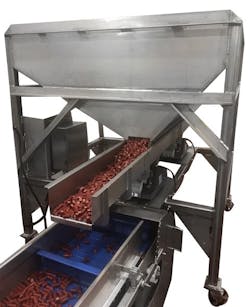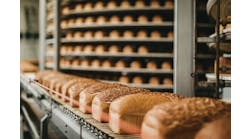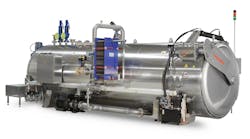Speed and efficiency: two things nearly every food or beverage processing plant strives to achieve through innovation and in production capability.
Conveyor and product handling systems are the backbone of every food-processing operation and, as such, can support frontline growth in a plant’s production capacity. Although the need to move product has never changed, the ways by which it has been done, the safety measures taken for both the workers and the product, and the durability of the systems have improved over time.
The state of hygienic design
Today, to many processors and equipment manufacturers, it may go without saying how critical it is to design conveyor and product handling systems with hygiene top of mind for food processing applications. Brian Jenny, director of production engineering for Sargento, explains that the road to success now has fewer hurdles than it may have had the past, especially when processors are proactive and work with suppliers with a good grasp of proper sanitary design.
“At Sargento, we strive to lead in this space because of our commitment to food safety,” he says. “In addition to industry-wide sanitary design standards and guidelines — such as published USDA and 3-A standards — we have captured internal best practices in hygienic design in our equipment design standards, [which] we share with suppliers during project requests for proposal (RFPs), specification development and factory acceptance test (FAT) activities.”
The North American Meat Institute (NAMI) Guidelines for Sanitary Design are a great starting point to address equipment and conveyor design, believes John Johnson, adjunct professor with Liberty University with more than 30 years working for global food processors and equipment managers.
“[However,] there will always be opportunities for improvement, as there are limitations on conveyor designs based on mechanical and engineering principles,” he says. “Challenges will always exist on how to incorporate cleanability into design.”
Hygienic design has evolved over the years to feature open, easy-to-clean designs with sloping surfaces and few crevices and hidden pinch points where bacteria might hide and thrive. Conveyors have been engineered to be easier for sanitation workers to disassemble, deep-clean and reassemble in a shorter amount of time than their predecessor designs.
The influence of automation
As automation has taken hold of food-processing plants, conveying systems have had to adjust. Automated systems can work 24 hours, seven days a week — and at higher speeds than a manual line — which increases production volumes and reduces downtime, but can also shorten the lifespan of the equipment handling the product.
“Conveyor parts wear out; this is an undisputed fact,” says Johnson. “The problem I have seen is attempting to extend parts beyond their physical life.”
Squeezing every last minute of operation out of a clearly worn part accelerates the wear of other parts, leading to further problems and additional costs, Johnson explains. Second, it creates a safety issue for food and personnel, as excessive wear can lead to product contamination and potential mechanical issues.
“A well-managed preventative maintenance program will extend the overall life of equipment and ensure a more accurate budget when calculating the cost to produce,” he adds. Part of that program might include innovative technology that incorporates real-time monitoring of conveyor and product handling systems, which allows plant operators to detect potential problems early and make adjustments as needed.
Sargento has benefitted from innovative changes to products, processes and robust hygienic design of bearing assemblies, leading to fewer failures and increased time before replacements are needed — invaluable contributions that Jenny says were made by the company’s experts on the engineering team.
“Their knowledge, as well as the innovative designs that facilitate the displacement and removal of conveying components, have really helped the efficiency of sanitation and maintenance at Sargento,” he says.
Robots, cobots and AGVs
Once product is packaged and needs to move off the line and into cartons, onto pallets and into storage, those tasks historically were reliant upon people to physically make those moves. However, robotic technology has become quite prevalent across all segments of the food industry, with robotic arms, pick-and-place equipment and cobots now able to handle an enormous variety of shapes and sizes of product and boxes — and do so with a gentle touch when needed.
Combined with highly improved vision systems, robotic equipment can sort and stack product in predetermined ways and can take hazardous, repetitious or hazardous work out of the hands of the human beings in the plants.
From a workforce efficiency standpoint, robots do break down and require maintenance and repair, but they typically can run continuously and improve a facility’s productivity.
Automated guided vehicles (AGVs) have caught on as a solution in food & beverage plants as more companies see the safety benefits of removing manually driven forklifts, pallet jacks and the like. AGVs also can be used when a processor desires to reduce the chance of product contamination, such as transporting slice logs to and from smokehouses and drying rooms, for example. Less human contact minimizes the food safety risk.
With floorspace at a premium in many older plants and processors looking for more ways to squeeze production into those facilities, plant engineers seek ways to capitalize on flexibility and versatility, and the modularity of some conveyor systems help in that arena.
Conveyors that can be moved to feed different machinery make a tremendous difference in the plant’s operational efficiency, as it reduces downtime required for product changeovers. In addition, technology has advanced to allow for conveying systems that can redirect product automatically using sensors and varying the speed or direction of the belts. Product of different shape or size can be sent to a different level or on a different path depending on the equipment needed to further process or package it.
Worker safety remains paramount
Although automation and robotics have taken numerous workers away from hazardous situations, not every product handling task can be automated. Therefore, worker safety is not something food processors can sleep on.
“Two areas of concern should be the operation and cleaning/maintenance of conveyors; energy isolation (i.e., lockout/tagout) must be incorporated into any design,” Johnson says. Training on the operation, repair and cleaning of the equipment must be ongoing for all employees.
“It only takes a split second for an accident to occur and it is the responsibility for all personnel to take safety seriously,” he adds. Jenny explains that Sargento holds all employees to a high standard when it comes to worker safety.
“We capture our requirements in our machine design standards that are used for vendor and equipment selection, [and] we are continuously updating those standards with knowledge management business processes to capture lessons learned for human safety design requirements,” he says.
“We also provide classroom and on-the-job training delivered by expert manufacturing peers. Additionally, we use a software package to facilitate safety risk assessments and mitigation action plans, collaboratively, among our safety professionals, manufacturing and engineering teams.”
Even though moving product around a processing plant might appear elementary at first glance, advances in automation, hygienic design, versatility and durability have led to increased efficiency, improved product quality and enhanced food and worker safety.
As food processors look for more ways to improve the profitability of their plants, expect them to start with product handling and conveying systems as the backbone of any innovation.



